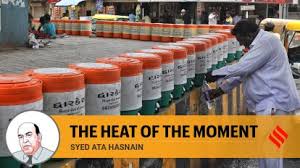14 Feb 2025 Indian Express Editorial
What to Read in Indian Express Editorial( Topic and Syllabus wise)
Editorial 1 : The Heat of the Moment
Context: We need to tackle heatwaves with greater urgency.
Introduction: Climate change has enhanced the frequency of disasters and, among them, a silent killer is the heatwave. India is experiencing more frequent, prolonged and severe heatwaves. These extreme temperatures pose significant risk to public health, infrastructure, and livelihoods, especially in vulnerable regions.
Heatwave Crisis in India
- Climate Change Impact
- Increased frequency, duration, and severity of heatwaves due to climate change.
- Global temperature rise (1.5°C threshold breached in 18 of 19 months until January 2025) makes heatwaves a silent killer.
- Public Perception Gap
- Disasters are perceived as risks for ‘others’, leading to low preparedness.
- Limited public awareness about heatwave risks despite their growing threat.
Impacts of Heatwaves
- Public Health
- 90% of Indians are vulnerable to heat-related illnesses.
- Overburdened healthcare systems, especially in rural areas.
- Economic Stability
- Productivity losses due to outdoor workforce vulnerability.
- World Bank estimates 34 million job losses by 2030.
- Water Resources
- 54% of India’s land faces high-to-extreme water stress (WRI).
- Groundwater depletion and rising demand strain water security.
- Agriculture: Crop failures, reduced yields, and higher irrigation demands threaten food security.
- Energy Sector
- Surge in power demand for cooling systems strains supply.
- 70% of power from thermal plants (water-dependent) face efficiency losses during heatwaves.
NDMA’s Strategic Initiatives
- Heat Action Plans (HAPs)
- Decentralized approach: 250+ HAPs developed for states, districts, and cities.
- Guidelines for preparedness, including early warnings and localized vulnerability assessments.
- National Framework for Heatwave Mitigation (2024)
- Shift from short-term response to long-term mitigation.
- Key innovations:
- Community participation and multi-sectoral collaboration.
- Institutional capacity-building and financing mechanisms.
- Coordination Efforts
- Designated officers for heatwave management.
- Encouraging states to declare heat as a disaster for better resource allocation.
- Strengthened IMD-NDMA coordination for localized alerts via Common Alerting Protocol (CAP).
Implementation Challenges
- Scaling and Local Ownership
- Limited success in translating HAPs into actionable outcomes.
- Need for community-driven solutions and dynamic HAP updates.
- Inter-Departmental Coordination: Fragmented efforts across urban planning, healthcare, labour, and energy sectors.
- Resource Allocation: Financing gaps for sustainable infrastructure (e.g. green cooling solutions).
Way Forward: Future Directions
- Infrastructure Adaptation
- Cool roofs, green spaces, and rainwater harvesting to reduce urban heat islands.
- Cool rooms and water kiosks in high-risk areas.
- Early Warning Systems: CAP-enabled alerts for timely public communication.
- Workforce Protection: Revised working hours and cooling vests for outdoor labourers.
- Healthcare Preparedness: Heatwave protocols at hospitals and primary healthcare centres.
- Water Security: Promotion of rooftop rainwater harvesting and efficient irrigation.
Conclusion: India’s heatwave crisis demands urgent, multi-sectoral collaboration. NDMA’s framework and HAPs provide a roadmap, but success hinges on local ownership of mitigation strategies, innovations and continuous data-driven updates to policies.
Editorial 2 : Tango With Paris
Context: India-France ties: A stable partnership in a turbulent world.
Background: AI Action Summit
- Talks between Prime Minister Narendra Modi and French President Emmanuel Macron on the sidelines of the multilateral AI Action Summit in Paris (co-chaired by the two leaders) signalled significant progress made in key areas.
- Focus Areas: nuclear energy, defence cooperation and joint projects in third countries.
Key Areas of Cooperation
- Nuclear Energy Collaboration
- Nuclear collaboration has emerged as a cornerstone of India-France ties.
- Both countries have committed to jointly developing nuclear reactors, as reflected in the signed letter of intent on small modular reactors and advanced modular reactors.
- France, a global leader in nuclear reactor technology, brings critical expertise to India’s expansion plans on nuclear energy.
- This aligns with the Indian government’s target of generating 100 gigawatts of nuclear energy by 2047.
- French energy giant Électricité de France (EDF) is already working with the Nuclear Power Corporation of India to develop next-generation reactors, including the Jaitapur nuclear plant, which is set to become the world’s largest with a proposed capacity of 9,900 megawatts.
- Defence Cooperation
- Project-75(I): Aimed at acquiring 6 next-gen submarines with air-independent propulsion (AIP). Delays due to vendor negotiations, policy shifts, and budgetary constraints.
- Rafale Jets: 36 Rafale fighters acquired in 2016 strengthened Indo-French military ties.
- Joint Exercises: Naval drills like Varuna in Indo-Pacific underscore shared maritime security goals.
Challenges in Bilateral Ties
- Systemic Inefficiencies in India
- Defence Procurement Delays: Red tape, policy revisions, and funding issues hinder modernization (e.g. stalled Project-75(I)).
- Nuclear Sector Reforms: Need to amend laws to attract foreign investment (e.g. unresolved legal hurdles for U.S./French firms).
- Geopolitical Risks: Global unpredictability, including U.S. policy shifts under Trump (e.g. ambiguous stance on Ukraine/Russia).
Geopolitical Context
- France as a Reliable Partner
- Backs India’s bid for UNSC permanent seat.
- Shared Indo-Pacific security interests countering Chinese assertiveness.
- U.S.-Europe Uncertainty: Trump’s engagement with Putin raises concerns about Europe’s security framework, amplifying France’s role as a stable ally.
Conclusion: PM Modi has visited France six-times, while President Macron last visited Delhi in January 2024 as the chief guest for India’s 75th Republic Day. India must leverage this special relationship while insulating it from systemic inefficiencies. Sustained focus on reforms, efficient implementation, and geopolitical alignment will determine the partnership’s long-term success.


